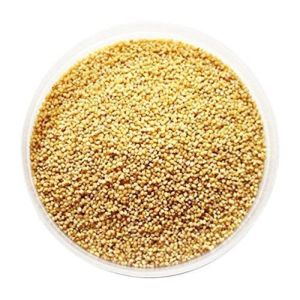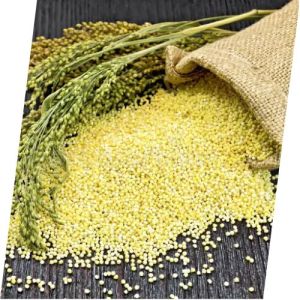
Parboiled Foxtail Millet
95 - 110 Per Kilogram
50000 Pack (MOQ)

foxtail millet
75 - 90 Per Kilogram
1 Kilogram (MOQ)
Best Deals from Foxtail Millet

foxtail millet
Get Price Quote
100 Kilogram (MOQ)

Foxtail Millet Flour
80 - 90 Per Kilogram
1 Ton (MOQ)

foxtail millet
70 Per Kilogram
500 Kilogram (MOQ)
Used for human food, animal feeding, and fodder. We are the exporter of Foxtail millet

foxtail millet
Get Price Quote
1 Ton (MOQ)

1836 Foxtail Millet
25 - 30 Per Kilogram
100 Kilogram (MOQ)
A nutritious grain used in South Indian cuisine for making dishes like upma and pongal. Our Foxtail Millet, or Kangni, is a versatile and nutty grain. Rich in fiber and nutrients, it's a perfect alternative to rice in various dishes, from pulao to porridge, adding a delightful texture and nutritional boost.

Yellow Foxtail Millet
Get Price Quote
1 Ton (MOQ)

foxtail millet
Get Price Quote
1000 Kilogram (MOQ)

foxtail millets
Get Price Quote

foxtail millet
Get Price Quote
100 Kilogram (MOQ)
Experience the rich nutrition and versatility of Foxtail Millet Grains, a premium gluten-free superfood that enhances the health and taste of your meals. Sourced from the finest Foxtail Millet crops, our grains are carefully processed to ensure top-tier quality and flavor. Health Benefits: · Gluten-Free: Ideal for those with gluten sensitivities, offering a safe and delicious alternative for gluten-free diets. · High Fiber Content: Promotes digestive health and aids in weight management by enhancing the feeling of fullness. · Rich in Protein: Provides a good source of plant-based protein, essential for muscle repair and overall vitality. · Nutrient-Dense: Packed with essential vitamins and minerals such as iron, magnesium, and B vitamins, supporting overall health and well-being. · Low Glycemic Index: Helps regulate blood sugar levels, making it suitable for individuals managing diabetes. Possible Uses · Healthy Breakfast: Cook Foxtail Millet Grains as a nutritious porridge or add them to your morning cereal mix for a wholesome start to your day. · Side Dish: Use as a nutritious substitute for rice or quinoa in pulao, salads, and grain bowls. · Baking: Incorporate Foxtail Millet Grains into bread, muffins, and energy bars for added texture and nutrition. · Main Course: Create delicious and healthful dishes like millet pulao, khichdi, and risotto, adding a unique twist to traditional recipes. Our Foxtail Millet Grains are available in various packaging options to suit your specific needs, including bulk quantities and private label packaging. Whether for commercial use or retail distribution, we offer customizable packaging sizes and designs to align with your branding requirements.

Panera Foxtail Millet
350 Per Packet
200 Packet (MOQ)

foxtail millets
Get Price Quote
1 Ton (MOQ)

thinai foxtail millet
Get Price Quote
100 Pack (MOQ)

foxtail millet
Get Price Quote
1 Metric Ton (MOQ)

Organic Foxtail Millet
Get Price Quote
5 Metric Ton (MOQ)

Thinai rice
400 Per Kilogram
5 Kilogram (MOQ)

Foxtail Millet Flour
300 Per Kilogram
100 Kilogram (MOQ)

foxtail millet
Get Price Quote
5000 Dozen (MOQ)
Foxtail Millet S.No. Test/Parameter Limit/Standard Remark (A) PHYSICAL PARAMETERS: Dimensions mm - Thousand Kernel Weight g - Test Weight kg/hl Min 55 Mineral Matter % Max 2.0 Milling Degree % - Density g/cm³ - Insect Damaged Grains % Max 2.0 Immature Grains % Max 2.0 Weeviled Grains % Max 1.0 (B) CHEMICAL PARAMETERS: Ash Content % Max 2.0 Moisture Content % Max 12.0 Uric Acid mg/kg Max 100 Ergot % Absent Alcoholic Acidity % Max 0.10 Protein Content % Min 12.0 Crude Fiber % Max 5.0 Crude Fat % Max 5.0 Starch Content % Min 50.0 Acid Insoluble Ash % Max 0.1 Total Dietary Fiber % Min 8.0 (C) MICROBIOLOGICAL ANALYSIS: Total Plate Count CFU/g Max 10,000 Yeast and Mold Count CFU/g Max 1,000 E. coli MPN/g Absent Salmonella - Absent Aflatoxin ppb Max 10

foxtail millet
50 - 60 Per Kilogram
1 Ton (MOQ)
Nutritional Profile Foxtail millet is highly nutritious, offering a range of essential nutrients. It is rich in carbohydrates, dietary fiber, and proteins, making it a valuable source of energy. It contains significant amounts of minerals such as iron, magnesium, phosphorus, and potassium. It is also a good source of vitamins like niacin, vitamin B6, and folate. Health Benefits Gluten-free: Foxtail millet is naturally gluten-free, making it a suitable grain for individuals with celiac disease or gluten intolerance. Rich in Antioxidants: It contains antioxidants like polyphenols and flavonoids, which help in combating oxidative stress and reducing the risk of chronic diseases. Low Glycemic Index: It has a low glycemic index, which means it doesn’t cause a rapid spike in blood sugar levels, making it beneficial for managing diabetes. Heart Health: The presence of magnesium in foxtail millet supports heart health by regulating blood pressure levels and reducing the risk of cardiovascular diseases. Culinary Uses Foxtail millet can be cooked and consumed similar to rice or other grains. It can be boiled, steamed, or roasted. It is commonly used in porridges, pilafs, salads, soups, and as a rice substitute in various dishes. In some regions, it’s fermented and used to make traditional alcoholic beverages. Its mild, nutty flavor makes it versatile for both sweet and savory preparations. Cultivation and Adaptability Foxtail millet is a hardy, drought-tolerant crop that thrives in semi-arid regions with low rainfall. It requires minimal water and is relatively resistant to pests and diseases, making it a sustainable crop option. Its short growing season and ability to grow in diverse soil types make it suitable for small-scale farming and marginal lands. Cultural Significance Foxtail millet has deep cultural and culinary significance in many Asian countries, particularly in India and China. It features prominently in traditional festivals, rituals, and ceremonies in various communities. Historically, it has been a staple food for millions of people, especially in regions where other grains may not thrive due to climatic conditions. Economic Importance Foxtail millet cultivation contributes significantly to the livelihoods of small-scale farmers in many developing countries. It serves as a reliable source of income and food security for rural communities, particularly during times of crop failures or environmental stress.